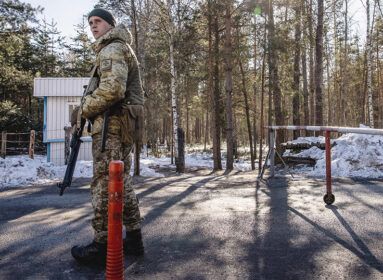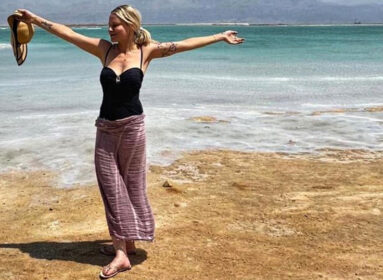By Cindy Mindell
Every year since 1966, the American Veterans of Israel Legacy Corporation returns to the U.S. Military Academy at West Point to honor graduate Col. David “Mickey” Marcus (1901-1948), a Brooklyn boy who helped shape Israel’s military and was named by David Ben Gurion as the fledgling country’s first military general.
The American Veterans of Israel (AVI) is a fraternal organization of American and Canadian volunteers who served in Israel’s War of Independence and on the clandestine immigrant ships. On Sunday, May 5, the group held its 47th commemoration, honoring the 41 fellow North American volunteers who fell during Israel’s War of Independence (1947-1949).
For the first 18 years, the annual service was held at Marcus’s grave, the only one in the West Point Cemetery for an American killed fighting under the flag of another country. Marcus was killed by friendly fire just hours before a cease fire went into effect. Since 1984, when the campus Jewish chapel was completed, the two-part commemoration begins in the chapel and concludes in the cemetery, where Marcus’s wife, Emma, is also buried.
Over the last several years, the event’s organizers have focused on specific groups of military veterans involved in the defense of the Jewish state, including Christian volunteers and women of “Machal,” the Hebrew acronym for “volunteers from abroad.” This year’s commemoration honored the North American veterans of Aliyah Bet, who operated the American-sourced ships that clandestinely brought Holocaust survivors from Europe to Palestine between 1934 and 1948. Among the 12 Machal veterans honored were Woodbridge resident Dr. Moses Stambler, 83 and former South Windsor resident Irv Meltzer, 90. Their stories are included below.
West Point’s Jewish Community chaplain, Maj. Henry Soussan, officiated at the memorial program along with West Point Chaplain Col. Barbara K. Sherer, the first woman ever to participate in the service. Ambassador Ido Aharoni, Consul General of Israel in New York, delivered greetings from the Government of Israel and presented commemorative lapel pins to the Aliyah Bet veterans.
The memorial service at the graveside of Col. and Emma Marcus included a recitation of the names of the fallen and Kaddish. The ceremony concluded with the presentation of colors by the USMA Honor Guard, laying of wreaths, a 21-gun salute, and the sounding of “Taps” by a bugler.
The commemoration was complemented by a photo exhibition, “Heroes from Abroad: The Machal/Aliyah Bet Legacy,” produced by the American Jewish Historical Society, home to the Machal archives. The show tells of the nearly 1,500 North American men and women, among volunteers from other countries, who fought for Israel’s independence, many after having been recently decommissioned from service in World War II. The “Machalniks” risked their lives, as well as their North American citizenship, by piloting the ships that illegally transported thousands of Holocaust survivors to Palestine in the face of a determined British naval blockade. Subsequently, the Machalniks joined the fight to establish modern Israel’s independence. Machal’s achievements remain largely unheralded even today.
Connecticut natives and residents who participated as Machalniks include Irving Block (Bridgeport), Sholom Bloom (West Hartford), Rabbi Joe Heckelman (Waterbury), Riena Kaplow Leopold (Waterbury), Hymie Malbin (Westport), Alice Mileikowsky Marder (Hartford), Irving Meltzer (South Windsor), Reuben Plen (Windsor), Sarah Plen (Windsor), Max Schwartz (New Haven), Paul Shulman (Stamford), Adolph Schwimmer (Bridgeport), Arthur Spiegel (Woodbridge), Willie Tillo (Woodbridge), Marvin Weiss (Branford), and Marcia Widman (Waterford).
Two Connecticut boys in Aliyah Bet
Irving Meltzer grew up in Glen Cove, Long Island, and served as a ship’s radio officer on Merchant Marine convoys through treacherous Nazi-held sea routes during World War Two. He survived the toughest voyage a sailor could draw in the war: the Murmansk run, in which American ships braved Nazi submarines, air attacks, and the weather to bring vital supplies to the Soviet Union via the Arctic Ocean port of Murmansk. During that period, he got what he calls “his first smell of refugees,” Norwegian villagers being evacuated to Scotland.
When the war ended, he found himself at a Jewish community center in Bremen, Germany, where Holocaust survivors had gathered to search for surviving relatives. It was there that he quickly learned about the movement that sought to restore a Jewish state in what was then British-ruled Palestine.
“I asked them, ‘What will you do next? Where will you go?’ They said, ‘We’re going to Palestine. We will walk in the snow over the Alps to get there,” Meltzer recalls.
Back in New York, he quickly learned that American Jews were purchasing U.S. vessels from scrap heaps and manning them to transport refugees from Europe to Palestine. The transports were illegal and required running past British blockades. Irving wanted in on the action and soon was the radio officer on the “Northland,” a former Coast Guard ice-breaker, renamed the “Jewish State” (“Medinat Hayehudim”). Between 1946 and 1948, risking British naval blockades, rough seas and leaky ships, arrest and detention, injury and death, Meltzer and the other North American Machalniks would transport some 32,000 refugees to Palestine.
Moses Stambler was only 17 when he embarked for Palestine. In his native Brooklyn, Stambler was a member of Betar, the militant Zionist youth group associated with the Irgun and the Revisionist Party. “We were impelled by searing revelations of six million Jews murdered in Nazi death camps, heroic fighters of the Warsaw Ghetto, stories and songs of heroic resistance by Jewish partisans in the forests of Europe, reports about sailors on immigrant ships like the SS Exodus 1947 attempting to run the British blockade with cargoes of concentration-camp survivors, and inadequate U.S. response to the Holocaust,” Stambler says.
In preparation for their mission, Betar members received paramilitary training – rifle- and target-practice on Staten Island, and gun-dismantling sessions in Brooklyn. They also passed around tzedakah boxes in the New York subways to raise money for the Irgun, and handed out stickers to visiting Royal Navy personnel that read, “Hey Limey, Jew-killers are not welcome in New York City.”
In November 1947, in Hoboken, N.J., Stambler and his fellow crew-members boarded the Ruth Wang, a converted 300-ton landing-craft vessel from World War Two. They set out two months later, even though the ship was not yet seaworthy. They arrived in Marseilles in mid-July and made their way to the Villa Faraggiana displaced persons camp in northern Italy, where they were driven with a group of refugees to an eastern port. There, they boarded the Pan York together with some 2,500 refugees for a five-day journey to the newly-proclaimed State of Israel.
Comments? email cindym@jewishledger.com.








 Southern New England Jewish Ledger
Southern New England Jewish Ledger













